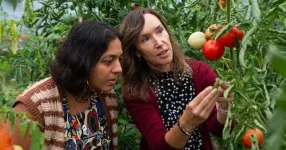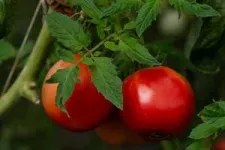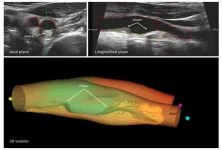(Press-News.org) Purdue-led TOMI project receives $3.5M grant to turn a decade of data into new tools and strategies for tomato farmers
WEST LAFAYETTE, Ind. — Indiana ranks third in the nation for tomato production. Lori Hoagland, a professor in Purdue University’s Department of Horticulture and Landscape Architecture, recently received a third grant from the U.S. Department of Agriculture’s National Institute of Food and Agriculture (USDA-NIFA) for the Tomato Organic Management and Improvement (TOMI) project, allowing her to focus on sharing data and developing strategies so tomato farmers across the nation can experience similar success.
Hoagland said there are two kinds of tomato production in Indiana. Ketchup and canning companies like Red Gold form the industrial side, which relies on tomato crops grown in large fields. Fresh-market tomatoes, often grown on a small scale to sell unprocessed, may generate less revenue, but they are a fast-growing, popular option for both consumers and growers.
Hoagland came to Purdue 14 years ago with a background in improving the sustainability of farming operations by transitioning from traditional to organic practices in grain, fruit and hop production systems. That experience prepared her to research tomatoes, one of Indiana’s biggest specialty crops. She kicked off TOMI in 2014 by asking farmers what issues they were noticing in their fields. Their overwhelming response was foliar diseases, or diseases on the leaf caused by fungal and bacterial pathogens.
“Specifically, fresh-market growers were concerned about the diseases early blight, late blight and Septoria leaf spot. And so I worked with a team across the United States of people with expertise in organic farming, soil microbial ecology, tomato breeding and pathology to come up with a plan to help overcome this challenge,” Hoagland said.
This team currently consists of researchers and Extension experts from Oregon State University, eOrganic, Organic Seed Alliance, North Carolina State University, University of Hawaiʻi at Mānoa, Virginia State University and University of Wisconsin-Madison. Connecting with organizations and universities across the nation created opportunities for the research to cover regional differences in production.
Originally funded in 2014 and again in 2019 by the USDA-NIFA Organic Agriculture Research and Extension Initiative, the decade of collaboration in TOMI has improved soil health, biocontrol practices, tomato breeding and partnerships with farmers. The $3.5 million grant that Hoagland received this past September emphasizes the development of new tools to use this data and on-farm trials to test them.
Hoagland’s lab team has looked back to the wild ancestors of tomato plants from South America to better understand the genetics of the crop and find lost traits that would be useful for modern varieties, like disease resistance. The team found that, even though these wild ancestors do not produce big or flavorful tomatoes like modern varieties, they form beneficial relationships with microbial populations in the soil that help them fight pathogens.
“There is a small cost to the plants when they form these microbe associations. Plants give away carbon to then get protection from pests or obtain nutrients from these microbes,” Hoagland explained. “When you domesticate a plant, you’re selecting under very high-input conditions. So, it looks like some modern plants may have shut those microbial relationships down because they don’t need it when they are fed lots of nutrients and treated with lots of chemicals.”
The TOMI team is finding markers in the genomes of these wild ancestors that correspond to greater microbial associations. Then, with selective breeding, they are bringing that trait and others back into modern tomato plants. Some advanced lines from their breeding program are already in trial with organic seed companies.
Through the first two phases and continuing in the third, the TOMI team has engaged in participatory plant breeding. This practice puts the generation of new tomato varieties in the hands of local farmers and customers. With help from researchers, farmers select the plants that best suit their soil, climate and management style. Chefs test which tomatoes work well in their favorite dishes, and consumers buy and pay the most for the best taste and texture. By hearing these voices, the TOMI team has given control of new tomato varieties to every stakeholder, building local supply chains and increasing the regional success of the crop.
While Hoagland believes this preventative measure is the best option for strengthening the plants’ defense against foliar pathogens, the TOMI team is also testing different organisms to find effective biocontrol agents. Biocontrol, or using one organism to control another, is possible because of complex interactions of microbes in the soil and on leaves — both places where biocontrol agents can be applied. Microbes can work together or against each other in competition for resources. Adding or removing just one population of microbes to the system can trigger domino effects for the rest of the microbiome.
Hoagland said they are working to understand how to promote the survival of these biocontrol agents and enhance their natural populations in soil. “Moving forward in this next phase, we will be using some bacillus species as a model to understand why and how they survive in different environments,” she said.
Since the first two phases of TOMI, weather patterns, scientific research and the production of tomatoes have all experienced change. Where late blight was a major problem in 2014, gray mold now causes more damage in the increasingly popular high tunnels — an affordable hybrid of greenhouse and field production that extends growing seasons. TOMI researchers have had to adapt their strategies and practices to keep pace with these changes.
One of the major objectives for this next phase is to make TOMI data useful for farmers moving forward and flexible enough to keep up with a continuously changing climate. Assistant professor Ankita Raturi of the Department of Agricultural and Biological Engineering is taking the massive amount of data and distilling it into tools that growers can use to help inform their farm management decisions. She will do this by training machine learning models, a subset of artificial intelligence that can find and analyze patterns in data to predict certain outcomes, like yield under various weather and disease conditions.
“Our design challenge revolves around creating user-friendly digital tools that leverage high-quality research datasets,” Raturi said. “We want to provide farmers and other decision-makers with the right data, in the right place and at the right time to support action! That’s both short-term, tactical decision support around disease management, as well as more strategic support for farm-specific variety selection.”
With those decision-support tools, Hoagland and the rest of the TOMI team are looking forward to interacting more with farmers. They are taking their research to the field and working with producers to test their new tomato varieties and biocontrol applications.
Hoagland said these on-farm trials are the most meaningful part of her work. “Here at the university, we have a lot of knowledge, but the farmers are seeing things that I would never see. They are constantly experimenting and have really good ideas. They may not have the science to understand the phenomenon that’s happening or know how to replicate it — that’s where a scientist can come in and help them. It really is a joint collaboration to develop solutions moving forward.”
Also in this latest phase of the project, TOMI will emphasize outreach and inclusion. Hoagland and her collaborators realized that their research was being found and used by growers with ties to land-grant universities, but less so by those without those connections. TOMI will be creating new support networks, hosting seminars and producing Extension publications to help organic farmers, Extension educators, researchers, students, chefs and consumers connect. From production to taste, the TOMI team is engaging in community participatory research and fostering new marketing relationships for their novel tomato varieties.
Even after a decade on the project, Hoagland is energized by her research and collaborators. Her favorite part has been watching her students learn and grow. From one student publishing a paper and being approached by general audiences and the press alike, to another becoming a professor at the University of Hawaiʻi at Mānoa, Hoagland measures her success by watching her lab members flourish and help farmers, in tomatoes and beyond.
“Developing more sustainable production systems will help all growers,” Hoagland said.
About Purdue University
Purdue University is a public research institution demonstrating excellence at scale. Ranked among top 10 public universities and with two colleges in the top four in the United States, Purdue discovers and disseminates knowledge with a quality and at a scale second to none. More than 105,000 students study at Purdue across modalities and locations, including nearly 50,000 in person on the West Lafayette campus. Committed to affordability and accessibility, Purdue’s main campus has frozen tuition 13 years in a row. See how Purdue never stops in the persistent pursuit of the next giant leap — including its first comprehensive urban campus in Indianapolis, the Mitch Daniels School of Business, Purdue Computes and the One Health initiative — at https://www.purdue.edu/president/strategic-initiatives.
Writer: Lindsey Berebitsky, lberebit@purdue.edu, 765-749-5296
END
Purdue-led TOMI project receives $3.5M grant to turn a decade of data into new tools and strategies for tomato farmers
2024-09-30
ELSE PRESS RELEASES FROM THIS DATE:
Could a bout of COVID protect you from a severe case of flu?
2024-09-30
More than 200 viruses can infect and cause disease in humans; most of us will be infected by several over the course of a lifetime. Does an encounter with one virus influence how your immune system responds to a different one? If so, how? Does it weaken your defenses, boost them, or have some other impact altogether?
These are questions Rockefeller University scientists from the Laboratory of Virology and Infectious Disease,headed by Charles M. Rice, and Weill Cornell Medicine’s Laboratory of Epigenetics and Immunity, headed by Steven Z. Josefowicz, teamed up to answer in a new study published in the journal Immunity. ...
When detecting depression, the eyes have it
2024-09-30
Hoboken, N.J., September 30, 2024 – It has been estimated that nearly 300 million people, or about 4% of the global population, are afflicted by some form of depression. But detecting it can be difficult, particularly when those affected don’t (or won't) report negative feelings to friends, family or clinicians.
Now Stevens professor Sang Won Bae is working on several AI-powered smartphone applications and systems that could non-invasively warn us, and others, that we may be becoming depressed.
“Depression is a major challenge,” says Bae. “We want to help.”
"And since most people in the world today use smartphones daily, this could ...
NRG Oncology trial implies the addition of atezolizumab concurrently to standard of care does not improve survival in limited-stage small cell lung cancer
2024-09-30
The addition of the cancer immunotherapy drug atezolizumab to the standard of care concurrent chemoradiation (cCRT) did not improve overall survival for patients with limited-stage small cell lung cancer (LS-SCLC) in the second planned interim analysis of the NRG Oncology/Alliance NRG-LU005 clinical trial. These results were recently reported during the Plenary Session of the American Society for Radiation Oncology Annual Meeting in Washington, DC.
“While atezolizumab given concurrently with chemoradiation did not improve survival, we have still learned quite a bit from these findings. With the success of the ADRIATIC trial ...
NRG Oncology trial supports radiotherapy and cisplatin should remain the standard of care for p16+ oropharyngeal cancer
2024-09-30
The NRG Oncology NRG-HN005 phase II/III clinical trial did not meet the non-inferiority criteria to proceed to the phase III portion of the study. The phase II portion of the NRG-HN005 evaluated two experimental treatment arms against a control arm for patients with p16-positive (p16+, accepted as a surrogate for HPV+ status), locoregionally advanced oropharyngeal cancer. The interim futility results were recently reported during the Plenary Session of the American Society for Radiation Oncology Annual Meeting in Washington, DC.
“This ...
Progression of subclinical atherosclerosis predicts all-cause mortality risk
2024-09-30
A study carried out at Mount Sinaí Fuster Heart Hospital in New York in collaboration with the Centro Nacional de Investigaciones Cardiovasculares (CNIC) in Madrid provides important new information about atherosclerosis, a disease in which lipids (cholesterol) and other substances accumulate in plaques on the arterial wall, causing the vessels to harden and narrow, and increasing the risk of severe cardiovascular conditions.
The study, published in The Journal of the American College of Cardiology (JACC), was led by Dr. Valentín Fuster, Director of the Cardiovascular ...
Presence of subclinical atherosclerosis is marker of mortality and its progression increases risk of death
2024-09-30
The progression of atherosclerosis in people who have no symptoms of it is independently associated with the risk of dying from any cause, according to a new study led by researchers from Mount Sinai Fuster Heart Hospital, published September 30 in the Journal of the American College of Cardiology.
This research is also the first to show that advanced imaging can detect atherosclerotic disease of the large vessels long before the appearance of symptoms—an approach that could be used worldwide to prevent cardiovascular disease and risk of death. Together, the findings ...
Wang unlocking complex heterogeneity in large spatial-temporal data with scalable quantile learning
2024-09-30
Lily Wang, Professor, Statistics, College of Engineering and Computing (CEC), received funding for the project: “Collaborative Research: Unlocking Complex Heterogeneity in Large Spatial-Temporal Data with Scalable Quantile Learning.”
Wang and her collaborator, Huixia Judy Wang, Department Chair and Professor of Statistics at The George Washington University, are developing scalable and efficient quantile learning techniques and theories to address challenges in analyzing large-scale heterogeneous spatial and temporal data. These new analytical techniques will have wide-ranging applications, revolutionizing scientists’ understanding of spatial and temporal ...
Heart transplant patients from socioeconomically deprived areas face higher risk for postoperative complications, earlier death than others
2024-09-30
Heart transplant patients who live in socioeconomically disadvantaged areas are more likely to experience post-surgical complications and die within five years than patients who live in more advantaged areas, even when those patients were transplanted at topnotch high-volume hospitals, new UCLA research suggests.
The findings, to be published September 30 in the peer-reviewed Journal of Heart and Lung Transplantation, the official publication of the International Society for Heart and Lung Transplantation, suggest that a lack of access ...
Research alert: skin barrier protein also protects against inflammation
2024-09-30
Researchers at University of California San Diego School of Medicine have identified a new mechanism underlying inflammatory skin diseases, such as psoriasis and seborrheic dermatitis. They found that a protein essential in forming the skin’s protective barrier (ZNF750) also plays a role in controlling inflammation in skin cells, shedding light on why some people are more susceptible to inflammatory skin diseases than others. The study paves the way for more effective and personalized therapies for these debilitating diseases and also offers broader ...
Saint Luke’s and UMKC to lead nationwide study on pregnant people with heart disease in effort to help combat maternal morbidity, mortality
2024-09-30
KANSAS CITY, Mo. (September 30, 2024) – The University of Missouri-Kansas City Healthcare Institute for Innovations in Quality and Saint Luke’s Mid America Heart Institute today announced a nationwide, four-year observational study of U.S. pregnant people with cardiovascular disease to better understand and combat maternal mortality and morbidity.
The National Heart, Lung, and Blood Institute of the National Institutes of Health awarded more than $7.9 million to the UMKC Healthcare Institute for Innovations in Quality to fund the study, Heart Outcomes in Pregnancy Expectations (HOPE) ...



